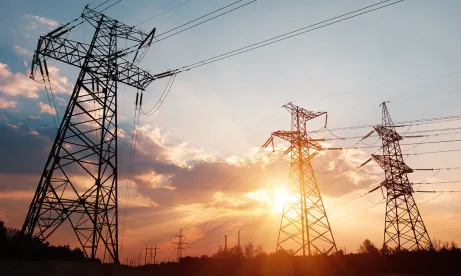On November 15th, 2021, President Biden signed the highly anticipated $1.2 trillion infrastructure bill. Among other infrastructure-related incentives, the bill includes billions in funding to help fight climate change and support clean energy technologies. Specifically, the bill allocates approximately (1) $65 billion for power infrastructure, of which nearly $29 billion is devoted to bolstering the electric grid (including transmission), (2) $47.2 billion to address critical cyber and climate resilience and (3) $7.5 billion to build out a national network of electric charging infrastructure.[1] These incentives are critical for facilitating broader proliferation of renewable energy projects and the transmission assets needed to carry their output to load centers, which is expected to help the nation achieve stated climate change goals.
According to the Bipartisan Infrastructure Investment and Jobs Act Summary, the legislation establishes a $2.5 billion revolving loan fund to allow the Department of Energy (“DOE”) to serve as an “anchor-tenant” for new or upgraded transmission lines,[2] and allows the DOE to issue loans to, or enter into public-private partnerships with, eligible transmission projects. This would allow the DOE to purchase various portions of the planned capacity, which it then may turn around and sell after determining that the transmission project has ensured financial viability[3]. Additionally, the bill allocates $5 billion to establish the Energy Infrastructure Federal Financial Assistance Program, which will provide funding for innovative approaches to the development of electric transmission, storage and distribution infrastructure. The bill also gives the Federal Energy Regulatory Commission authority to approve transmission construction permits or modify interstate transmission facilities in so-called National Interest Electric Transmission Corridors that have otherwise been blocked or rejected by state commissions.
The bill also provides incentives for the burgeoning clean hydrogen industry. For example, the bill establishes multiple clean hydrogen programs, including (i) authorizing $8 billion towards developing regional clean hydrogen hubs to demonstrate “the production, processing, delivery, storage and end use of clean energy”, (ii) authorizing $500 million towards a clean hydrogen manufacturing and recycling program to support a clean hydrogen domestic supply chain, and (iii) a $1 billion demonstration, commercialization and deployment program aimed at decreasing the cost of clean hydrogen production from electrolyzers.[4]
Additionally, the bill contains incentives designed to support increased production of electric vehicles by authorizing $7.5 billion to develop electric vehicle charging infrastructure and vehicle-to-grid infrastructure, in addition to allocating $5 billion to implement a Clean School Bus Program. Of the $5 billion allocated to the Clean School Bus Program, 50% of the funds will be authorized for zero-emission school buses and the remaining 50% will be authorized for alternative fuel and zero-emission school buses.[5]
Other relevant provisions in the bill include:
-
$3 billion for battery material processing grants and $3 billion for battery manufacturing and recycling;
-
$2.5 billion to expand the DOE’s Carbon Storage Validation and Testing program to include large-scale commercialization of new or expanded carbon sequestration projects and carbon dioxide transport infrastructure; and
-
$6 billion in subsidies for uneconomic nuclear power plants[6]
In addition, the House of Representatives is considering the $1.75 trillion companion to the infrastructure bill, the reconciliation bill, which includes over $550 billion for numerous clean energy incentives from tax credits for carbon capture to investments in clean energy deployment.
FOOTNOTES
-
InfrastructureInvestmentJobsActSectionbySectionSummary.docx (senate.gov).
-
Id.
-
Id.
-
Id.
-
Id.
-
Infrastructure Investment and Jobs Act, H.R. 3684, 117th Cong. (2021).






 />i
/>i
